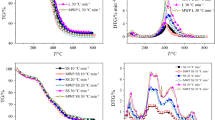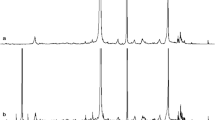Abstract
In order to improve the utilization efficiency of coal by microorganisms and increase gas production, ultrasound assisted hydrogen peroxide oxidation of lignite was studied. The changes of accumulated gas, methane content, carbon dioxide content, and fluorescence characteristics of intermediate products in lignite and oxidized lignite system were studied by drainage gas gathering method, gas chromatography (GC) and fluorescence spectrophotometer. It was found that the cumulative gas could be divided into three stages: rapid gas production, slow gas production, and basic stable stage. The methane production rate of raw coal and lignite treated by ultrasound assisted hydrogen peroxide reached 987.23 μmol/g and 1290.22 μmol/g, respectively. The methane yield for oxidized lignite was 30.69% higher than that of raw lignite. The ultrasonic-assisted hydrogen peroxide pretreatment for lignite could effectively increase methane production. The analysis results of the fluorescence characteristics of the intermediates indicated that the total fluorescence intensity (FI) integral of intermediates decreased with the increase of time. The fluorescence peak positions mainly changed in tyrosine aromatic proteins and soluble microbial metabolites. Ultrasound-assisted hydrogen peroxide pretreatment lignite changed the amount of tyrosine-based aromatic proteins, hydrophobic organic acid fulvic acid, humic acids, and soluble microbial metabolites in the slow and stable stages of lignite biogas.







Similar content being viewed by others
References
Barma SD, Sathish R, Baskey PK (2018) Ultrasonic-assisted cleaning of Indian low-grade coal for clean and sustainable energy. J Clean Prod 195(10):1203–1213
Catcheside DEA, Ralph JP (2002) Bioconversion of Coal by Fungi. In: Bioconversion of coal by fungi. Springer, Berlin
Chang C, Huang C, Chen C, Wang G (2020) Assessing the potential effect of extreme weather on water quality and disinfection by-product formation using laboratory simulation. Water Res 170:115296
Chen W, Westerhoff P, Leenheer JA, Booksh K (2003) Fluorescence excitation-emission matrix regional integration to quantify spectra for dissolved organic matter. Environ Sci Technol 37(24):5701–5710
Chen TY, Zheng H, Hamilton S, Rodrigues S, Golding SD, Rudolph V (2017) Characterisation of bioavailability of Surat Basin Walloon coals for biogenic methane production using environmental microbial consortia. Int J Coal Geol 179:92–112
Chen M, Chyou Y, Wang T (2019) Simulation of coal gasification in a low-temperature, high-pressure entrained-bed reactor with a volatiles condensation and re-evaporation model. Appl Sci 9(3):510
Ghosh S, Jha P, Vidyarthi AS (2014) Unraveling the microbial interactions in coal organic fermentation for generation of methane-A classical to metagenomic approach. Int J Coal Geol 125:36–44
Gupta P, Gupta A (2014) Biogas production from coal via anaerobic fermentation. Fuel 118:238–242
Haider R, Ghauri MA, SanFilipo JR, Jones EJ, Orem WH, Tatu CA, Akhtar K, Akhtar N (2013) Fungal degradation of coal as a pretreatment for methane production. Fuel 104:717–725
Hamidi H, Haddad AS, Mohammadian E, Rafati R, Azdarpour A, Ghahri P, Ombewa P, Neuert T, Zink A (2017) Ultrasound-assisted CO2 flooding to improve oil recovery. Ultrason Sonochem 35:243–250
Hamidi H, Haddad AS, Otumudia EW, Rafati R, Mohammadian E, Azdarpour A, Pilcher WG, Fuehrmann PW, Sosa LR, Cota N, García DC, Ibrahim RM, Damiev M, Tanujaya E (2021) Recent applications of ultrasonic waves in improved oil recovery: a review of techniques and results. Ultrasonics 110:106288
Haq SR, Tamamura S, Igarashi T, Kaneko K (2018) Characterization of organic substances in lignite before and after hydrogen peroxide treatment: Implications for microbially enhanced coalbed methane. Int J Coal Geol 185:1–11
Huang Z, Urynowicz MA, Colberg PJS (2013) Stimulation of biogenic methane generation in coal samples following chemical treatment with potassium permanganate. Fuel 111:813–819
Jian K, Chen G, Guo C, Ma G, Ru Z (2019) Biogenic gas simulation of low-rank coal and its structure evolution. J Pet Sci Eng 173:1284–1288
Jones EJP, Voytek MA, Corum MD, Orem WH (2010) Stimulation of methane generation from nonproductive coal by addition of nutrients or a microbial consortium. Appl Environ Microbiol 76(21):7013–7022
Klein J, Pfeifer F, Schacht S, Sinder C (1997) Environmental aspects of bioconversion processes. Fuel Process Technol 52(1-3):17–25
Li X, Li C, Bai Y, Shi X, Su R (2019) Composition variations and spatiotemporal dynamics of dissolved organic matters during the occurrence of green tide (Ulva prolifera blooms) in the Southern Yellow Sea, China. Mar Pollut Bull 146:619–630
Li X, Pu CS, Chen X, Huang F, Zheng H (2021) Study on frequency optimization and mechanism of ultrasonic waves assisting water flooding in low-permeability reservoirs. Ultrason Sonochem 70:105291
Liu J, Wang B, Tai C, Wu L, Zhao H, Guan J, Chen L (2016) An effective method to detect volatile intermediates generated in the bioconversion of coal to methane by gas chromatography-mass spectrometry after in-situ extraction using headspace solid-phase micro-extraction under strict anaerobic conditions. PLoS One 11(10):0163949
Lupton N, Connell LD, Heryanto D, Sander R, Camilleri M, Down DI, Pan ZJ (2020) Enhancing biogenic methane generation in coalbed methane reservoirs -Core flooding experiments on coals at in-situ conditions. Int J Coal Geol 219:103377
Machnikowska H, Pawelec K, Podgórska A (2002) Microbial degradation of low rank coals. Fuel Process Technol 77-78(2):17–23
Mullakaev MS, Abramov VO, Abramova AV (2017) Ultrasonic piezoceramic module and technology for stimulating low-productivity wells. J Pet Sci Eng 158:529–534
Nguyen V, Pierens X, Benhabib K (2019) Experimental and numerical study of methylparaben decomposition in aqueous solution using the UV/H2O2 process. J Environ Sci Heal 54(5):357–365
Orem WH, Voytek MA, Jones EJ, Lerch HE, Bates AL, Corum MD, Warwick PD, Clark AC (2010) Organic intermediates in the anaerobic biodegradation of coal to methane under laboratory conditions. Org Geochem 41(9):997–1000
Osiewacz HD (2003) The Mycota: A comprehensive treatise on fungi as experimental systems for basic and applied research. X. Industrial Applications. Mycologist 17(1):45–46
Papendick SL, Downs KR, Vo KD, Hamilton SK, Dawson GKW, Golding SD, Gilcrease PC (2011) Biogenic methane potential for Surat Basin, Queensland coal seams. Int J Coal Geol 88:123–134
Park SY, Liang YN (2016) Biogenic methane production from coal: a review on recent research and development on microbially enhanced coalbed methane (MECBM). Fuel 166:258–267
Robbins SJ, Evans PN, Esterle JS, Golding SD, Tyson GW (2016) The effect of coal rank on biogenic methane potential and microbial composition. Int J Coal Geol 154-155:205–212
Romanowska I, Strzelecki B, Bielecki S (2015) Biosolubilization of Polish brown coal by Gordonia alkanivorans S7 and Bacillus mycoides NS1020. Fuel Process Technol 131:430–436
Sabar MA, Ali MI, Fatima N, Malik AY, Jamal A, Farman M, Huang Z, Urynowicz M (2019) Degradation of low rank coal by Rhizopus oryzae isolated from a Pakistani coal mine and its enhanced releases of organic substances. Fuel 253:257–265
Sable SS, Shah KJ, Chiang P, Lo S (2018) Catalytic oxidative degradation of phenol using iron oxide promoted sulfonated-ZrO2 by advanced oxidation processes (AOPs). J Taiwan Inst Chem Eng 91:434–440
Shao P, Wang AK, Wang WF (2018) Experimental simulation of biogenic coalbed gas generation from lignite and high-volatile bituminous coals. Fuel 219:111–119
Shi Q, Qin Y, Li J, Wang Z, Zhang M, Song X (2017) Simulation of the crack development in coal without confining stress under ultrasonic wave treatment. Fuel 205:222–231
Takagi H, Isoda T, Kusakabe K, Morooka S (1999) Effects of solvents on the hydrogenation of mono-aromatic compounds using Nobel-metal catalysts. Energy Fuel 13:1191–1196
Tang Z, Zhai C, Zou Q, Qin L (2016) Changes to coal pores and fracture development by ultrasonic wave excitation using nuclear magnetic resonance. Fuel 186:571–578
Wang B, Tai C, Wu L, Chen L, Liu J, Hu B, Song D (2017) Methane production from lignite through the combined effects of exogenous aerobic and anaerobic microflora. Int J Coal Geol 173:84–93
Wang A, Shao P, Lan F, Jin H (2018) Organic chemicals in coal available to microbes to produce biogenic coalbed methane: a review of current knowledge. J Nat Gas Sci Eng 60:40–48
Wang Q, Guo H, Wang H, Urynowicz MA, Hu A, Yu C, Fallgren PH, Jin S, Zheng H, Zeng R, Liu F, Chen B, Zhang R, Huang Z (2019a) Enhanced production of secondary biogenic coalbed natural gas from a subbituminous coal treated by hydrogen peroxide and its geochemical and microbiological analyses. Fuel 236:1345–1355
Wang B, Yu Z, Zhang Y, Zhang H (2019b) Microbial communities from the Huaibei Coalfield alter the physicochemical properties of coal in methanogenic bioconversion. Int J Coal Geol 202:85–94
Whiticar MJ (1999) Carbon and hydrogen isotope systematics of bacterial formation and oxidation of methane. Chem Geol 161(1-3):291–314
Xiao D, Wang EY, Peng SP, Wu JY (2017) Responses of coal anaerobic fermentation fractures development. J China Coal Soc 42(5):1207–1212
Xiong Y, Jin L, Li Y, Zhu J, Hu H (2020) Hydrogen peroxide oxidation degradation of a low-rank Naomaohu coal. Fuel Process Technol 207:106484
Yuan H, Zhu N (2016) Progress in inhibition mechanisms and process control of intermediates and by-products in sewage sludge anaerobic digestion. Renew Sust Energ Rev 58:429–438
Zhang J, Li Y (2017) Ultrasonic vibrations and coal permeability: laboratory experimental investigations and numerical simulations. Int J Min Sci Technol 27(2):221–228
Zhang S, Yuan L, Li W, Lin Z, Li Y, Hu S, Zhao B (2017) Characterization of pH-fractionated humic acids derived from Chinese weathered coal. Chemosphere 166:334–342
Zhao T, Li P, Tai C, She J, Yin Y, Qi Y, Zhang G (2018) Efficient decolorization of typical azo dyes using low-frequency ultrasound in presence of carbonate and hydrogen peroxide. J Hazard Mater 346:42–51
Ziembowicz S, Kida M, Koszelnik P (2019) The use of alternative catalysts in processes of the chemical degradation of di-n-butyl phthalate in aqueous solutions. Chemosphere 237:12445
Acknowledgments
We would like to thank the editors and reviewers for their helpful suggestions and comments.
Funding
We would like to thank the National Natural Science Foundation of China (No. 41702174), the major project for Henan Province Joint Funds of the National Natural Science Foundation of China (No. U1704241), and the Plan for Scientific Innovation Talent of Henan Province, China (grant number 194200510010), for their support.
Author information
Authors and Affiliations
Corresponding author
Ethics declarations
Conflict of interest
The authors declare that they have no competing interests.
Additional information
Responsible Editor: Haroun Chenchouni
Rights and permissions
About this article
Cite this article
Wu, L., Li, H., Cao, B. et al. Study on gas characterization and fluorescence characteristics of intermediates in biogenic gas production from lignite by ultrasound assisted hydrogen peroxide pretreatment. Arab J Geosci 14, 296 (2021). https://doi.org/10.1007/s12517-021-06676-5
Received:
Accepted:
Published:
DOI: https://doi.org/10.1007/s12517-021-06676-5




